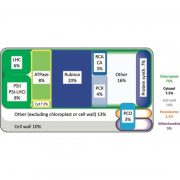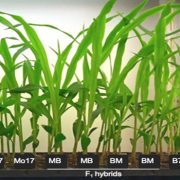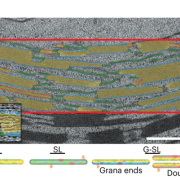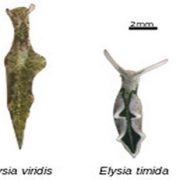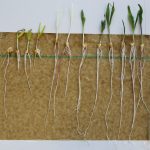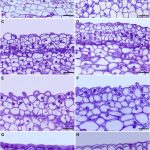Stimulating photosynthetic processes increases productivity and water-use efficiency in the field (Nature Plants)
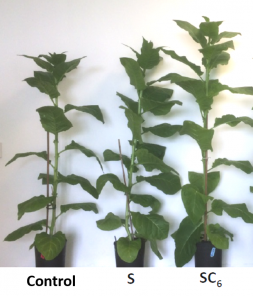 Yield potential in crops is determined by the efficiency of photosynthetic rates, which is a critical target for improvement. Previous studies have shown that photosynthetic carbon assimilation and plant biomass can be improved by the stimulation of either regeneration of RuBP (the five-carbon sugar that CO2 attaches to) or the electron transport chain. López-Calcagno et al. tested whether combining stimulation from both these processes could enhance photosynthesis and yield more as compared to stimulation of only one process. Two strategies were used to increase RuBP regeneration: expressing a cyanobacterial bifunctional enzyme fructose-1,6-bisphosphatase/sedoheptulose-1,7-bisphosphatase (FBP/SBPase) in SB plants, or overexpression of the plant enzyme sedoheptulose-1,7-bisphosphatase (SBPase) in S plants. Electron transport was enhanced by expression of the red algal protein cytochrome c6 (C6). The simultaneous stimulation of both processes in either SBC6 or SC6 plants had a greater impact on photosynthesis in comparison to the single manipulations (SB, S, or C6) in all plants analyzed. The double transgenics also presented increased biomass and yield under greenhouse and field conditions. Interestingly, in the field trial, stomatal conductance (gs) in the SBC6 plants was significantly lower, resulting in a higher intrinsic water-use efficiency (iWUE) for SBC6 plants. This genetic engineering approach has the potential to be further explored as a tool to enhance yield and reduce water consumption. (Summary by Camila Ribeiro @camicribeiro86) Nature Plants 10.1038/s41477-020-0740-1
Yield potential in crops is determined by the efficiency of photosynthetic rates, which is a critical target for improvement. Previous studies have shown that photosynthetic carbon assimilation and plant biomass can be improved by the stimulation of either regeneration of RuBP (the five-carbon sugar that CO2 attaches to) or the electron transport chain. López-Calcagno et al. tested whether combining stimulation from both these processes could enhance photosynthesis and yield more as compared to stimulation of only one process. Two strategies were used to increase RuBP regeneration: expressing a cyanobacterial bifunctional enzyme fructose-1,6-bisphosphatase/sedoheptulose-1,7-bisphosphatase (FBP/SBPase) in SB plants, or overexpression of the plant enzyme sedoheptulose-1,7-bisphosphatase (SBPase) in S plants. Electron transport was enhanced by expression of the red algal protein cytochrome c6 (C6). The simultaneous stimulation of both processes in either SBC6 or SC6 plants had a greater impact on photosynthesis in comparison to the single manipulations (SB, S, or C6) in all plants analyzed. The double transgenics also presented increased biomass and yield under greenhouse and field conditions. Interestingly, in the field trial, stomatal conductance (gs) in the SBC6 plants was significantly lower, resulting in a higher intrinsic water-use efficiency (iWUE) for SBC6 plants. This genetic engineering approach has the potential to be further explored as a tool to enhance yield and reduce water consumption. (Summary by Camila Ribeiro @camicribeiro86) Nature Plants 10.1038/s41477-020-0740-1



